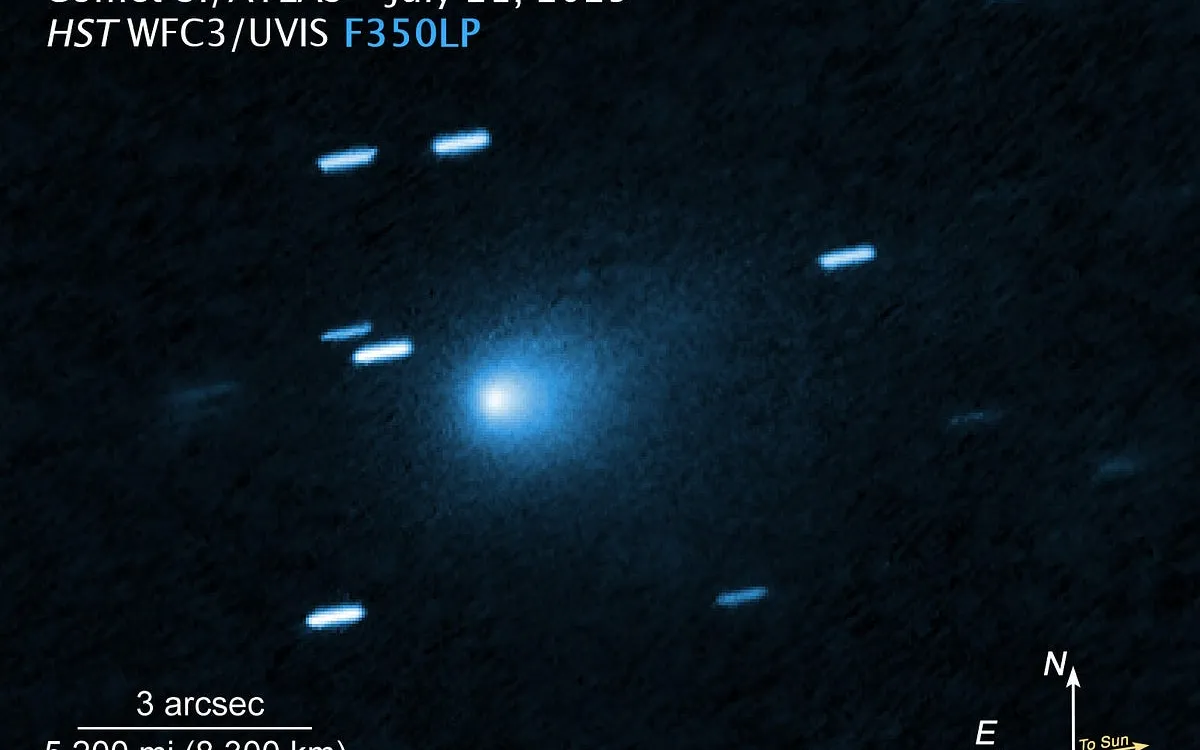
The latest observations of the interstellar object 3I/ATLAS were captured by the Hubble Space Telescope on July 21, 2025. This stunning image reveals a glow of light, likely emanating from a coma, which is positioned ahead of 3I/ATLAS as it travels towards the Sun. Notably, there is no evidence of a bright cometary tail trailing in the opposite direction. This glow is interpreted as the evaporation of dust from the Sun-facing side of 3I/ATLAS, suggesting unique characteristics about this celestial object.
The analysis paper, which includes a detailed figure (accessible here), presents a steep surface brightness profile of the glow with a projected power-law slope of -3. This slope implies a three-dimensional emissivity profile with a radial power-law slope of -4. This finding is particularly significant as it is steeper than what is typically observed in solar system comets. Collaborating with my esteemed colleague, Eric Keto, we discovered that this observed slope aligns with an alternative model where the dust outflow surrounding 3I/ATLAS is illuminated by a central light source. This model effectively accounts for the steep brightness profile, as the outflow density slope of -2 combines with the declining radiation flux from the central source, which also has a slope of -2.
If 3I/ATLAS generates its own light, it could be significantly smaller than previously estimated. The reflection model, which suggests a diameter of up to 20 kilometers, appears untenable. The limited reservoir of rocky material in interstellar space indicates that such a massive object could only occur once every 10,000 years or longer (as detailed in my research paper here).
After participating in the annual soccer cup match at Harvard's Institute for Theory & Computation, where I serve as director, I returned to my research on 3I/ATLAS the following morning. I calculated that the luminosity of 3I/ATLAS must be around 10 gigawatts. Furthermore, the steep brightness profile suggests that the nucleus of 3I/ATLAS is the primary source of the observed light, regardless of its origin. This means that the nucleus's light emission dominates over the glow surrounding it.
The illumination from sunlight cannot account for the steep 1/R⁴ profile of scattered light, where R represents the radial distance from the nucleus. This is because a steady dust outflow would develop a 1/R² profile, scattering sunlight in a similar emissivity profile. Sunlight would typically dominate the illumination in this scenario, as a rocky nucleus would reflect only a minimal portion of the solar intensity from a much smaller area than the 10,000-kilometer region resolved in the Hubble image.
Another hypothesis for the steep brightness profile is that the scattering halo consists of icy particles that evaporate as they approach the Sun from the warm side of 3I/ATLAS. This could explain the absence of a tail from these scattering particles. The evaporation time would need to be approximately 10 minutes, but it remains uncertain whether this would produce the observed 1/R⁴ brightness profile.
The simplest explanation remains that the nucleus of 3I/ATLAS is responsible for generating the majority of the light. I calculated that the nucleus cannot be a thermal emitter with an effective surface temperature below 1,000 degrees Kelvin; otherwise, its peak emission wavelength would exceed 3 micrometers, leading to an exponential cutoff at shorter wavelengths, which contradicts the data.
At higher effective temperatures, the required luminosity of 3I/ATLAS could originate from a source with a diameter smaller than 100 meters. This compact, bright emitter would align 3I/ATLAS in size with previous interstellar objects like 1I/`Oumuamua and 2I/Borisov, making the previously suggested 20-kilometer size based on sunlight reflection seem implausible.
What could be the source of the required light? Initially, I considered a primordial black hole with a Hawking temperature of 1,000 degrees Kelvin, but this would only produce 20 nanowatts of power—far from sufficient to power 3I/ATLAS. A rare fragment from a nearby supernova, rich in radioactive material, could potentially serve as a natural nuclear source, but this scenario is highly unlikely due to the scarcity of radioactive elements in interstellar space.
Alternatively, 3I/ATLAS might be a spacecraft powered by nuclear energy, and the emitted dust could be dirt accumulated on its surface during interstellar travel. While this theory cannot be dismissed, it requires further evidence to gain credibility. If we maintain the assumption that 3I/ATLAS is a natural object, we can consider the hypothetical scenario of an object heated through friction with the ambient medium. In this case, the momentum flux of the dust must exceed that of the ambient medium, known as the ambient ram pressure. Given the inferred mass loss rate (6–60 kilograms per second) and dust ejection speed (20–2 kilometers per second) from the Hubble observations, this model is marginally ruled out.
The interpretation of the brightness profile around 3I/ATLAS points towards a central light source. This theory is further supported by its finely-tuned trajectory. 3I/ATLAS is expected to pass within approximately 28.96 (+/-0.06) million kilometers from Mars on October 3, 2025, presenting an excellent opportunity for observation using the HiRISE camera onboard the Mars Reconnaissance Orbiter. This morning, I encouraged the HiRISE team to utilize their camera during the first week of October 2025 to gather additional data on 3I/ATLAS, and they responded positively. Observing 3I/ATLAS from Earth at that time will pose challenges due to its position relative to the Sun. The more data we collect on 3I/ATLAS, the closer we will get to uncovering its true nature.